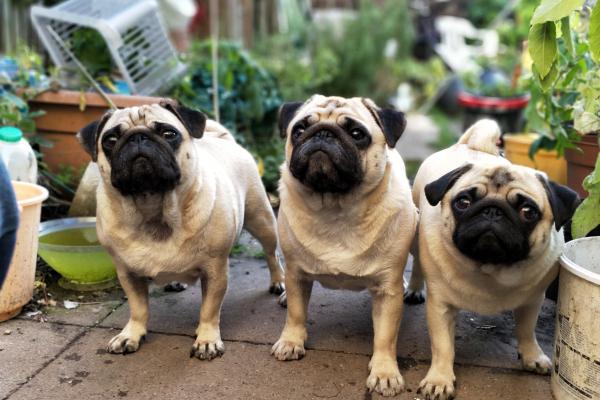Common Health Problems in Pug Dogs



Animal file: Pug
Pugs are a popular choice for many families and other pet companions. This is probably due to their adorable appearance and small size, making them great apartment pets. However, before adopting a Pug, it's best to know what common health issues they are prone to.
In this AnimalWised article, we're going to go through the different health issues Pug dogs are prone to having. This way, you can recognise the symptoms and prevent them as much as possible.
Health issues in Pugs
All pure dog breeds are prone to certain health issues. However, Pugs are known for having many different health issues. In fact, most Pugs can't even give birth naturally. Approximately 86% of Pugs need a C-section to be able to give birth.
So, why do Pugs have so many health issues? This is because brachycephalicTheir flat faces and wrinkles make them vulnerable to several medical conditions that don't affect other non-brachycephalic dog breeds.
With that being said, these Pugs have an average lifespan of 12-15 years. By being aware of the health issues they are prone to we can take better care of them and take them to the veterinarian as soon as we recognise a symptom. The most common health problems in dogs are as follows:
- Hearing problems
- Breathing problems
- Eye problems
- Skin disorders
- Bone and joint problems
- Neurological dysfunctions
- Prone to obesity
- Prone to diabetes
We are now going to go through these health issues and their symptoms and treatment.

Hearing problems
Ear infections
To prevent your Pug from suffering from an ear infection, it's best to clean their ears from time to time. When you keep their ears clean and dry, they are less likely to develop an ear infection. You may also be interested in learning more in our article about ear infections in dogs.
Symptoms of an ear infection in your Pug includes:
- Aggressive scratching or rubbing against hard objects.
- Excessive licking, biting, or chewing on skin.
- Redness, swelling, or odor around the ears.
- Brown, yellow, or bloody discharge.
- Hair loss, crusts, or scabs around the ears.
- Reluctance to chew.
- Unusual eye movements.
- Loss of balance.
The treatment will consist in a special ear cleanse done by your veterinarian. They may also encourage you to clean your dog's ears at home. In severe cases, your vet may prescribe oral antibiotics and anti-inflammatory medications.
Inflammation in the ear canal
The medical term for this occurrence is otitis. This is when the ear canal becomes inflated, red and swollen. This health problem is also known as “swimmer's ear” as dogs that are exposed to water or humidity are more prone to suffer from otitis. To prevent this issue, simply clean and dry your dog's ears regularly.
Symptoms of otitis in dogs include:
- Head shaking.
- Scratching at the affected ear.
- Dark discharge.
- Odor.
- Redness and swelling of the ear canal.
- Pain.
- Itchiness.
- Crusting or scabs in the ears.
The most common treatment to external otitis in dogs is topical therapy, a key component in the management of bacterial and yeast overgrowth.
Breathing problems
Did you know that 50% of Pugs experience breathing problems? In fact, only 7-15% of them are said to breathe like a normal non-brachycephalic
The most common breathing health issue in Pugs is the Brachycephalic Airway Obstruction Syndrome (BAOS), which refers to a particular set of upper airway abnormalities that affect brachycephalic dogs. The symptoms include:
- Breathing difficulty.
- Stress and heat intolerance when exercising.
- Snoring, gagging, choking and/or vomiting.
The most common treatment for BAOS in dogs consists in their stenotic nares being surgically corrected by removing a wedge of tissue from their nostrils. This way the dog will have improved airflow through their nostrils.
Unfortunately, this medical condition cannot be prevented as brachycephalic dogs are born with these conditions. Simply be aware of the symptoms and take your dog to the veterinarian as soon as you recognise your Pug experiencing any of these symptoms.

Eye problems
Pugs can suffer from many different eye problems. Many of these have similar symptoms, so it's important to take them to the veterinarian to be properly diagnosed and treated. The most common eye problems in Pugs are:
Cherry Eye
Symptoms include: redness, swelling, pronounced corner of the eyelid.
Treatment includes: tear duct surgery.
Corneal Ulcers
Symptoms include: redness, pain, squinting or your dog may keep their eyes closed, frequent rubbing, light sensitivity, discharge, and a noticeable film over the eyes.
Treatment includes: antibiotic eye drops, painkillers, possible surgery in severe cases.
Distichiasis
Symptoms include: redness, discharge, frequent rubbing, and itching.
Treatment includes: professional eye exam including fluorescent staining to assess the degree of injury, prescribed lubricants, possible surgical lash removal.
Entropion
Symptoms include: eyelid distortion (up or inward), milky look, redness, swelling, and constant scratching.
Treatment includes: surgery to remove excess eyelid.
Dry Eye
Symptoms include: redness, swelling, pronounced corner of the eyelid.
Treatment includes: prescribed oral medication, and possible eye drops.
Cataracts
Symptoms include: milky or cloudy look to the eyes, grayish film, noticeable vision loss, clumsiness.
Treatment includes: surgical removal with lens replacement or laser removal.
Progressive Retinal Atrophy
Symptoms include: noticeable night blindness, clumsiness, shinier look to eyes, and abnormal pupil dilation.
Treatment includes: although studies have shown that dietary changes can slow disease progression, at the time of this writing treatment is not available and blindness will eventually result.
Accidental Injury
Symptoms include: signs of pain, irritation, rubbing, watering, or visible scratches.
Treatment includes: inspect the area to determine if professional intervention is necessary.

Skin disorders
Pugs are known for their wrinkly skin. Although their wrinkles are adorable, they can also be a danger to their health as Pugs are prone to skin infections, especially the medical condition called lip-fold pyoderma. To prevent skin infections you will need to clean their wrinkles. Learn more in our article about caring for a dog's skin folds and wrinkles.
Symptoms include:
- Moistness
- Discharge
- Redness
- Foul odor
The treatment consists in antibiotics prescribed by the veterinarian. You will also need to clean and dry your dog's skin folds regularly to prevent it from happening again.
Bone and joint problems
Hip dysplasia
Hip dysplasia is common in pug dogs as they are genetically prone to this health condition. Obesity and bad nutrition can also play a role in the development of hip dysplasia.
You can prevent this condition by making sure your dog is at an ideal weight. If your dog is suffering from hip dysplasia, we recommend you read our article about which exercises help them in this condition.
Symptoms of hip dysplasia includes:
- Decreased activity.
- Pain.
- Stiffness.
- Decreased range of motion.
- Difficulty or reluctance rising, jumping, running, or climbing stairs.
- Lameness in the hind end.
- “Bunny hopping” gait.
- Grating in the joint during movement.
- Loss of thigh muscle mass.
Treatment includes:
- Weight reduction to take stress off of the hips.
- Exercise restriction, especially on hard surfaces.
- Physical therapy.
- Joint supplements.
- Anti-inflammatory medications.
- Joint fluid modifiers.
- Surgery.
Arthritis
Sometimes, hip dysplasia can cause arthritis. Other times, dogs develop it individually. The causes of this health issue is age, obesity, genetics and prior joint surgery. Many large size dogs are also prone to arthritis.
The only prevention one can take is to make sure our Pug is living a healthy lifestyle and are not overweight. Unfortunately, this is a condition that any dog can develop due to genetics or age.
Symptoms include:
- Difficulty getting up and down.
- Walking stiffly.
- Lameness in one or more legs.
- Reluctance to go up and/or down stairs.
- Reluctance to jump up or down (onto/off furniture or into/out of a vehicle)
- Stiff, swollen, or sore joints.
Treatment consists of a change in lifestyle (for example, exercise and diet), joint supplements, and pain control through NSAIDs medication.

Neurological disorders
The most common neurological disorder in Pugs is Pug dog encephalitis (PDE) a severe and debilitating disease in small breed dogs that causes inflammation of the brain. Unfortunately, this is inherited by Pugs, hence, why it is named after them.his disease is fatal and it is estimated that 1.2% of Pugs die from Pug encephalitis.
The symptoms of Pug dog encephalitis include:
- Circling.
- Disorientation.
- Head pressing.
- Inability to use one or more limbs.
- Pain.
- Behavioural changes.
- Sensitive to the touch.
- Seizures.
- Sudden weakness and/or stumbling.
Unfortunately, there is no cure for Pug encephalitis. Treatment is focused improving your pug's quality of life by minimizing symptoms. This includes decreasing the immune response, alleviating inflammation, and minimizing seizures. Your veterinarian may also prescribe steroids or other immunosuppressive drugs to manage the condition.
Other health issues
Prone to obesity
You can prevent this by making sure your dog has a healthy diet and is exercising regularly. If you notice that they have gained some weight, take them to the veterinarian to be examined.
Prone to diabetes
Lastly, pugs are also prone to diabetes. Diabetes has no cure, nevertheless, it can be managed successfully.
Symptoms include:
- Frequent urination.
- Frequent drinking.
- Greater appetite.
- Weight loss.
- Lethargy.
Treatment consists in changes in their diet and exercise. Your pug may also need certain injections if prescribed by the veterinarian. To avoid diabetes in your pug, simply provide them with high quality dog food and a healthy lifestyle. Unfortunately, that may not be enough for some pugs as many are prone to this disease genetically.
Now that you know what health problems pugs are prone to, you may be interested in learning more about this breed. Watch our video below where we talk about everything you need to know to care for a pug!
Adopting a dog is a beautiful thing. We must remember that all dogs are prone to certain diseases, we must simply be aware of them and help them live a happy and healthy life.

This article is purely informative. AnimalWised does not have the authority to prescribe any veterinary treatment or create a diagnosis. We invite you to take your pet to the veterinarian if they are suffering from any condition or pain.
If you want to read similar articles to Common Health Problems in Pug Dogs, we recommend you visit our Prevention category.
- Renee M. Barber, Scott J. Schatzberg, I.-S. (2011). Huentelman, Identification of Risk Loci for Necrotizing Meningoencephalitis in Pug Dogs, Journal of Heredity. https://doi.org/10.1093/jhered/esr048
- O’Neill, D.G., Darwent, E.C., Church, D.B.I.-S. (2016). Demography and health of Pugs under primary veterinary care in England. Canine Genet Epidemiol. https://doi.org/10.1186/s40575-016-0035-z
- Thornton K.C. (2005). The Everything Pug Book. Adams Media.









